Abstract
1. A novel preparation of the trachea and main bronchi with attached vagus nerve from the guinea-pig maintained in vitro was used to study the properties of single vagal afferent nerve fibres with identified receptive fields. 2. Recordings were made from twenty-eight C fibres with a mean conduction velocity of 0.9 +/- 0.1 m s-1 and twenty-four A delta fibres with a mean conduction velocity of 8.4 +/- 1.3 m s-1. Receptive fields for C and A delta fibres were of small diameter, distributed throughout the trachea and right bronchus and possessed very low mechanical thresholds of 2.2 +/- 0.4 and 1.1 +/- 0.3 mN respectively. 3. The chemosensitivity of isolated afferents was studied by applying drugs directly onto identified receptive fields. A delta fibres were insensitive to capsaicin (up to 3 microM), bradykinin (3 microM), histamine (10 microM) and 5-hydroxytryptamine (5-HT; 10 microM) applied for up to 1 min. Histamine (10 microM), 5-HT (10 microM) and m-chlorophenylbiguanide (10 microM) were also ineffective in exciting C fibres. 4. Capsaicin, at concentrations ranging from 30 nM to 3 microM, evoked a sustained firing of all C fibres tested when applied for a period of 30 s directly onto receptive fields. Bradykinin (0.1-1 microM) also potently excited C fibres in a concentration-related manner. The effect of bradykinin appeared to be mediated by a B2 receptor since it was not mimicked by the selective B1 receptor agonist [des-Arg9]-bradykinin (3 microM) and was abolished by prior application of the selective B2 receptor antagonist D-Arg-[Hyp3,Thi5,D-Tic7,Oic8]-bradykinin (HOE 140; 0.1 microM). HOE 140 was without effect against capsaicin-evoked discharge of C fibres. 5. Capsaicin- and bradykinin-evoked discharge of C fibres was present to a similar degree in preparations pretreated with ibuprofen (1 microM), indicating that it was not dependent on, or influenced by, endogenous prostaglandin production. 6. These data demonstrate that single vagal afferents may be studied in vitro and provide the first examination of the properties of sensory fibres innervating guinea-pig airways. C and A delta fibres both exhibit low threshold mechanical sensitivity but show marked differences in terms of their chemosensitivity.
Full text
PDF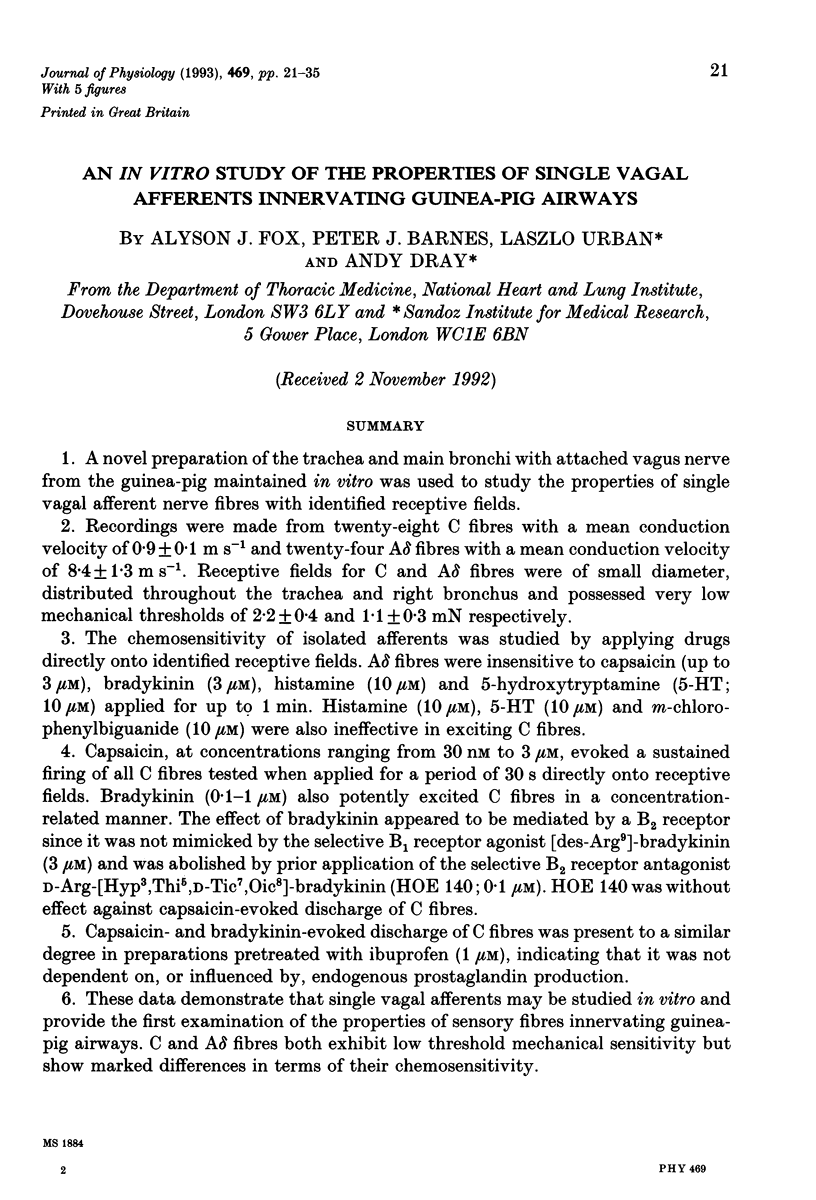
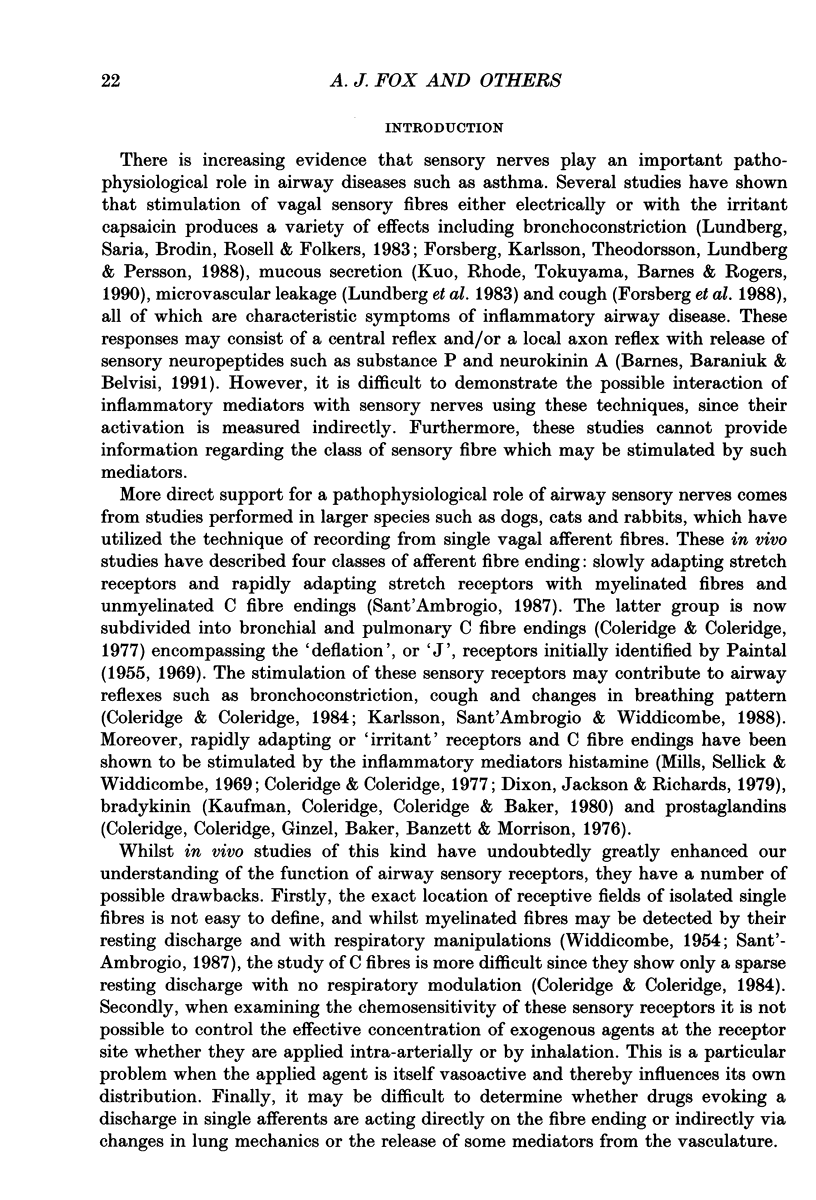
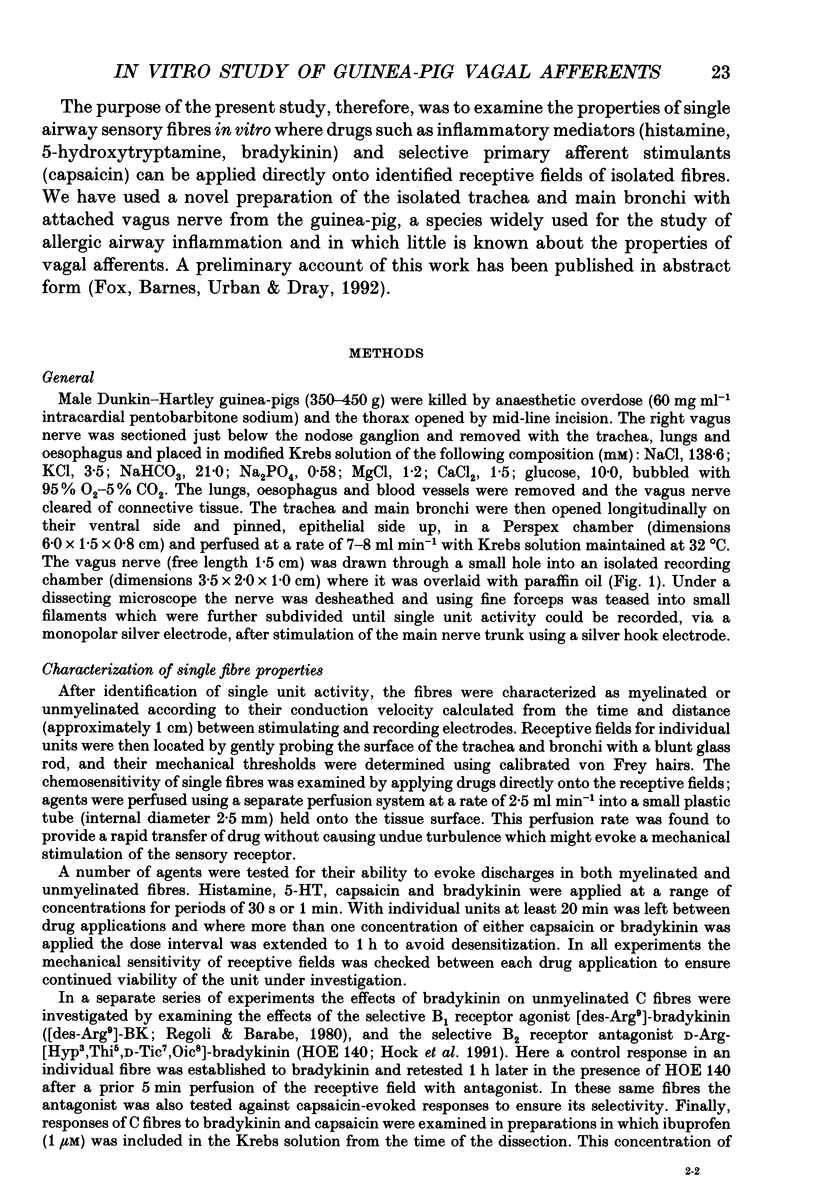
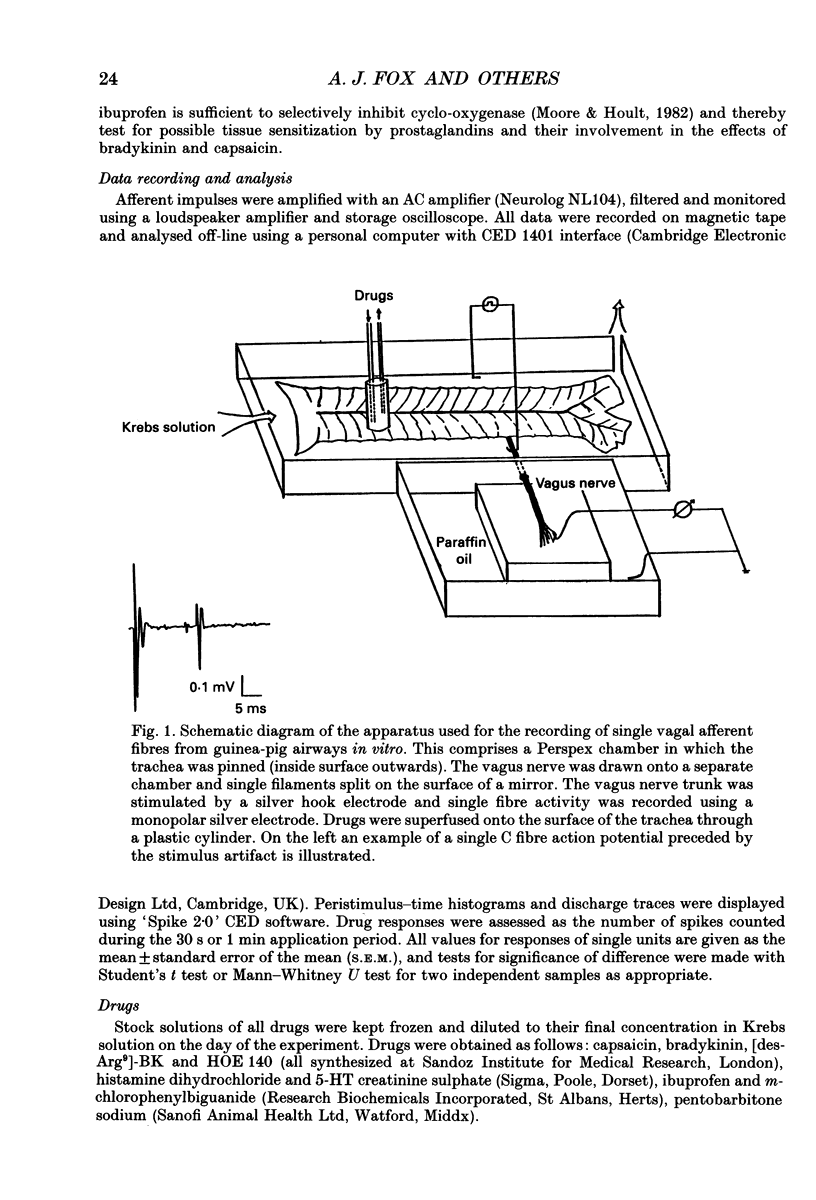

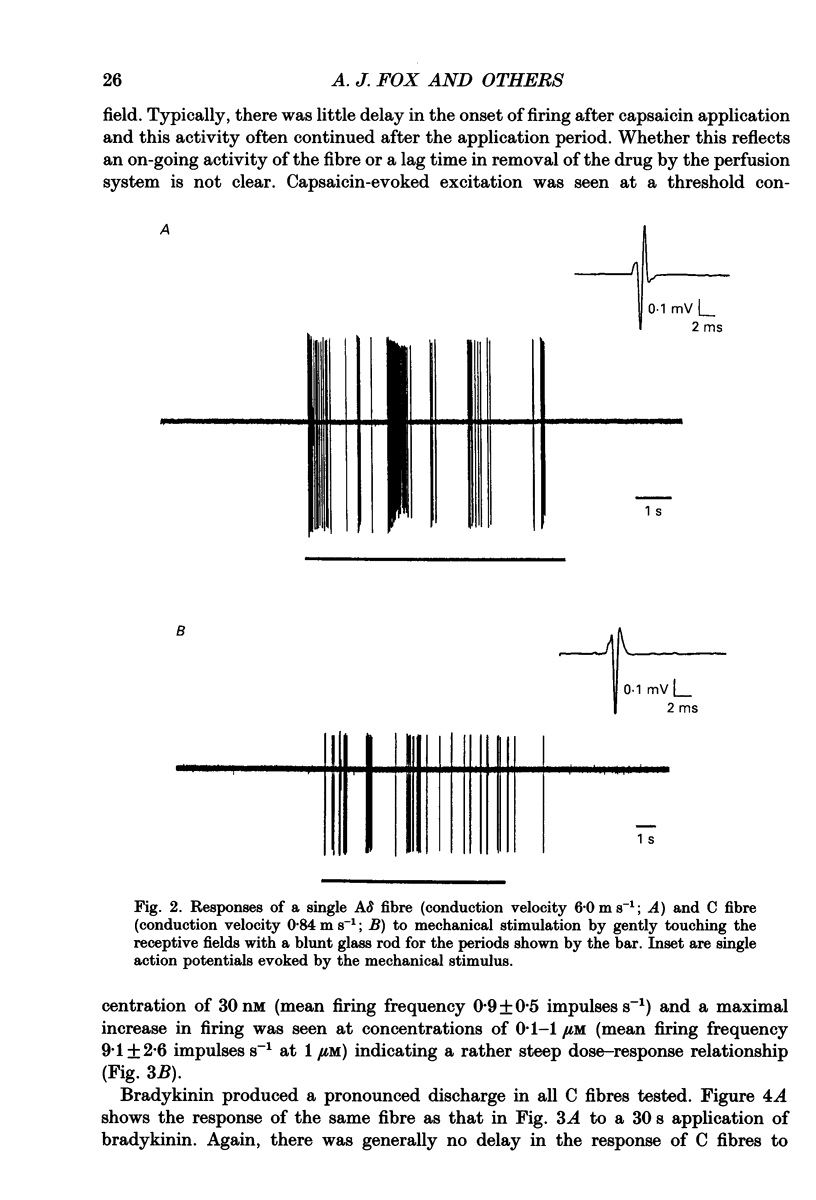
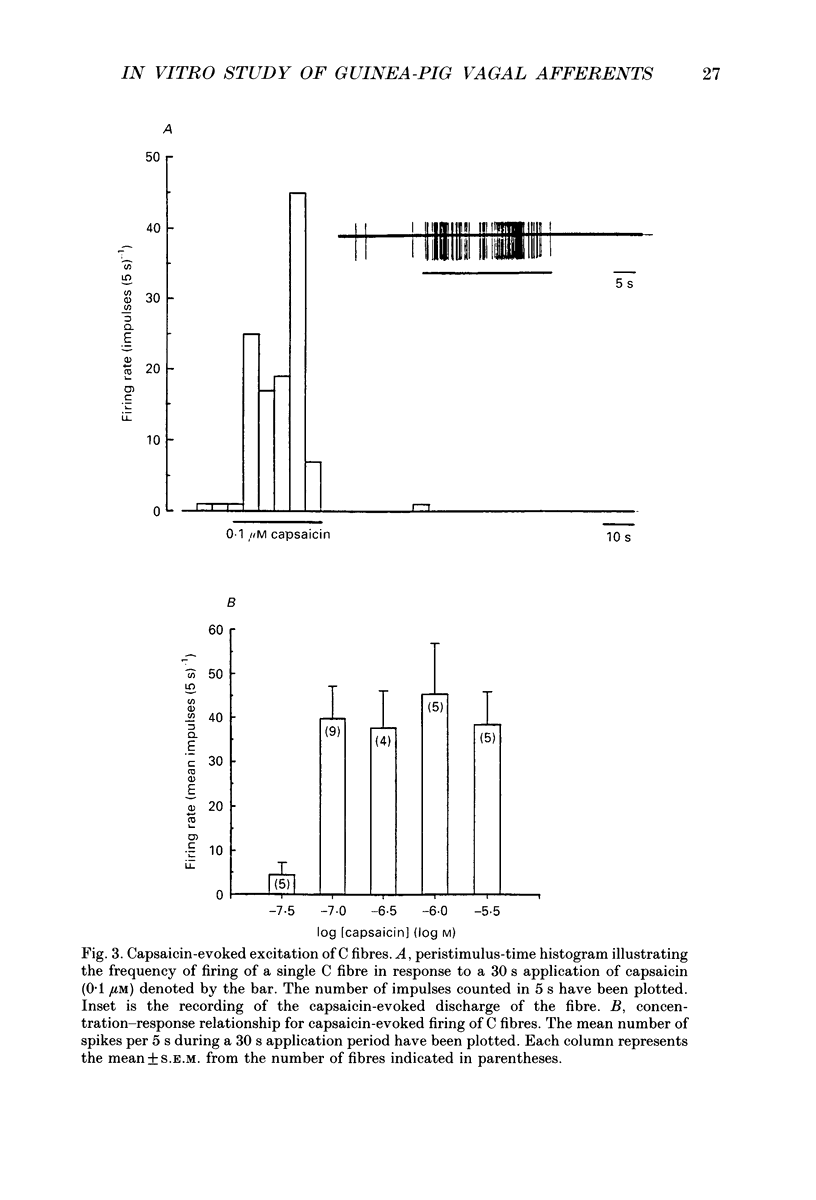
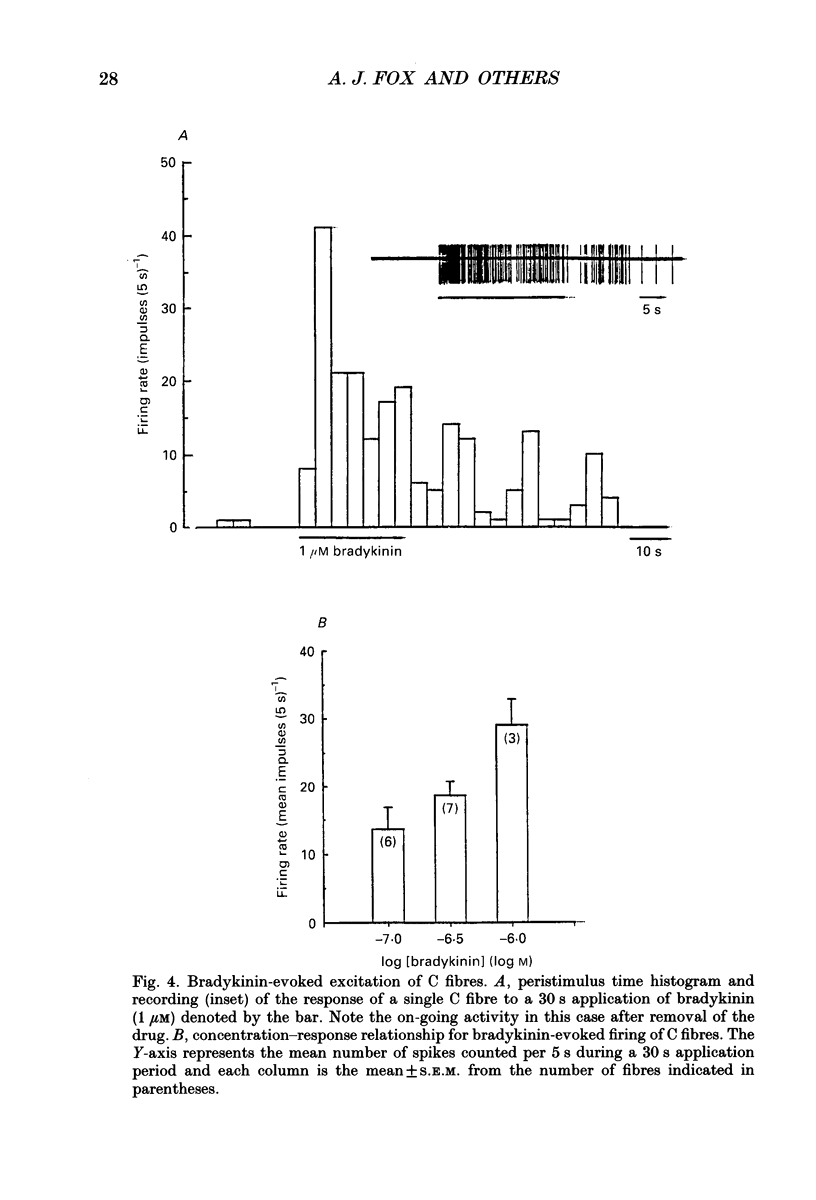
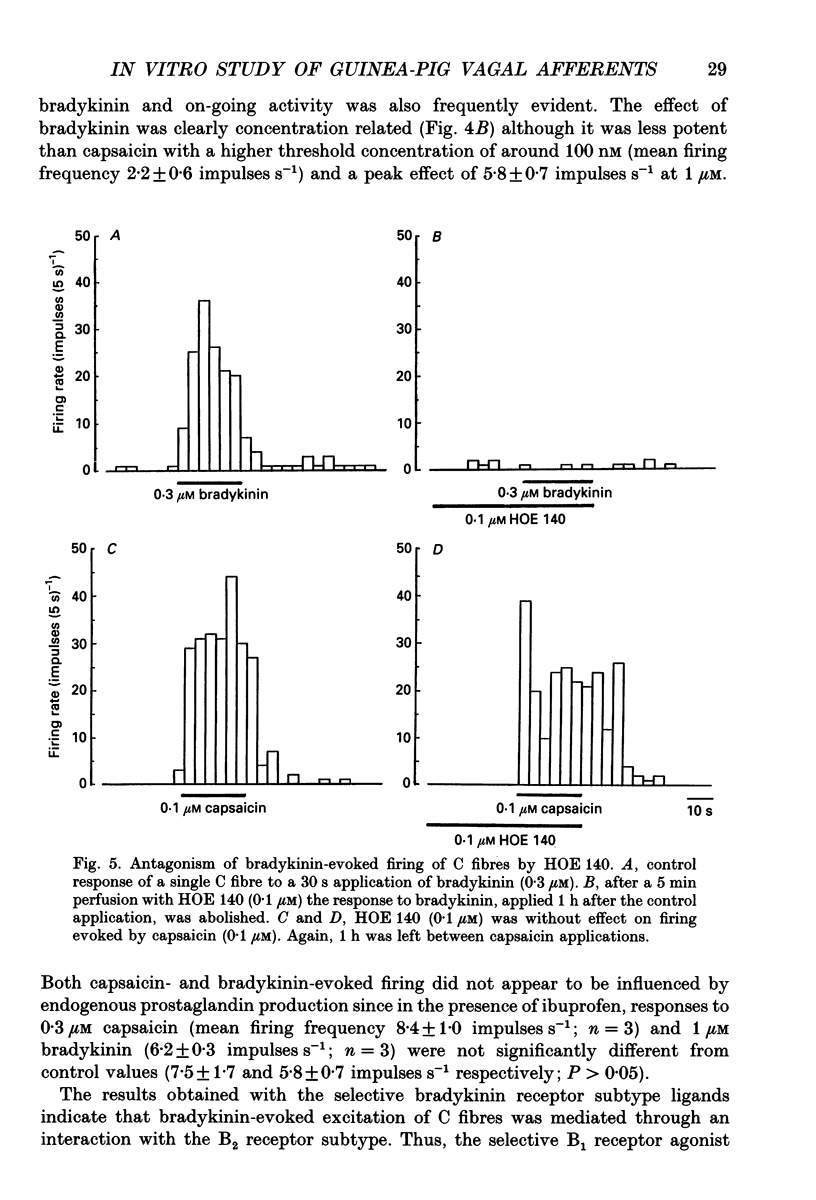
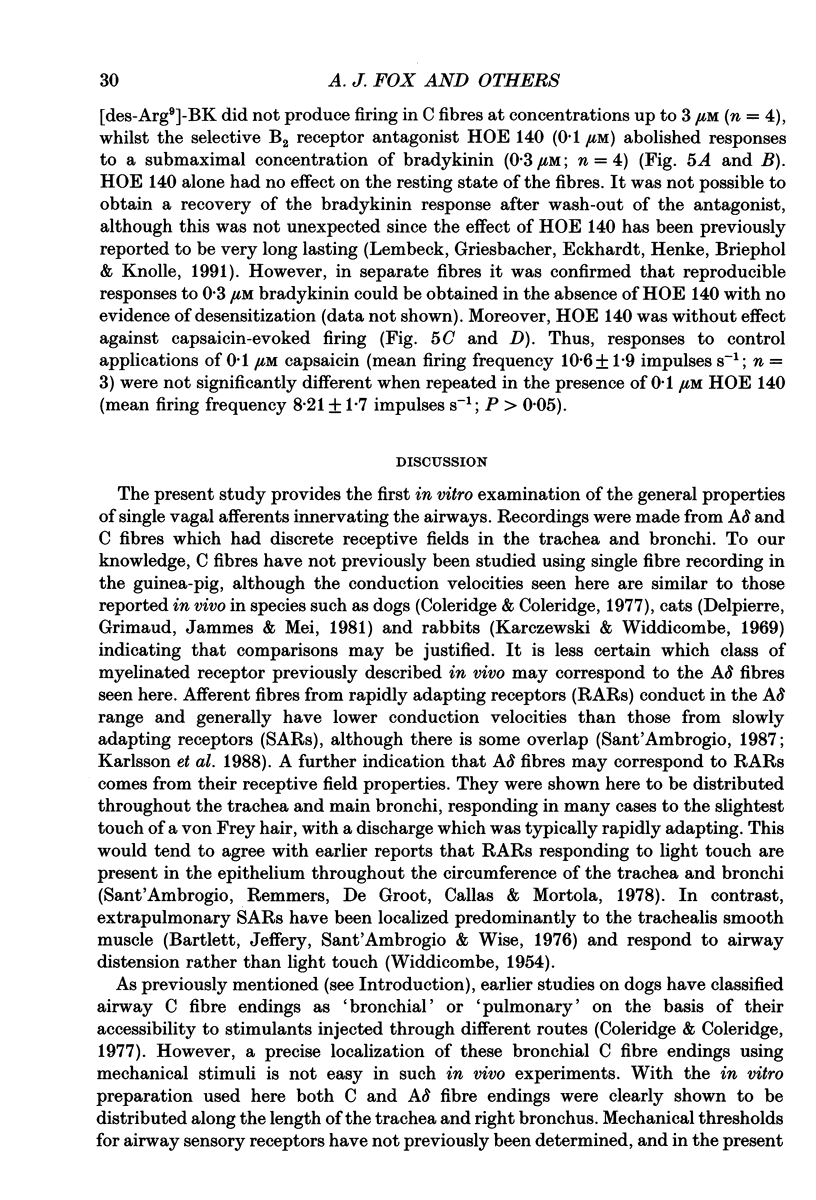
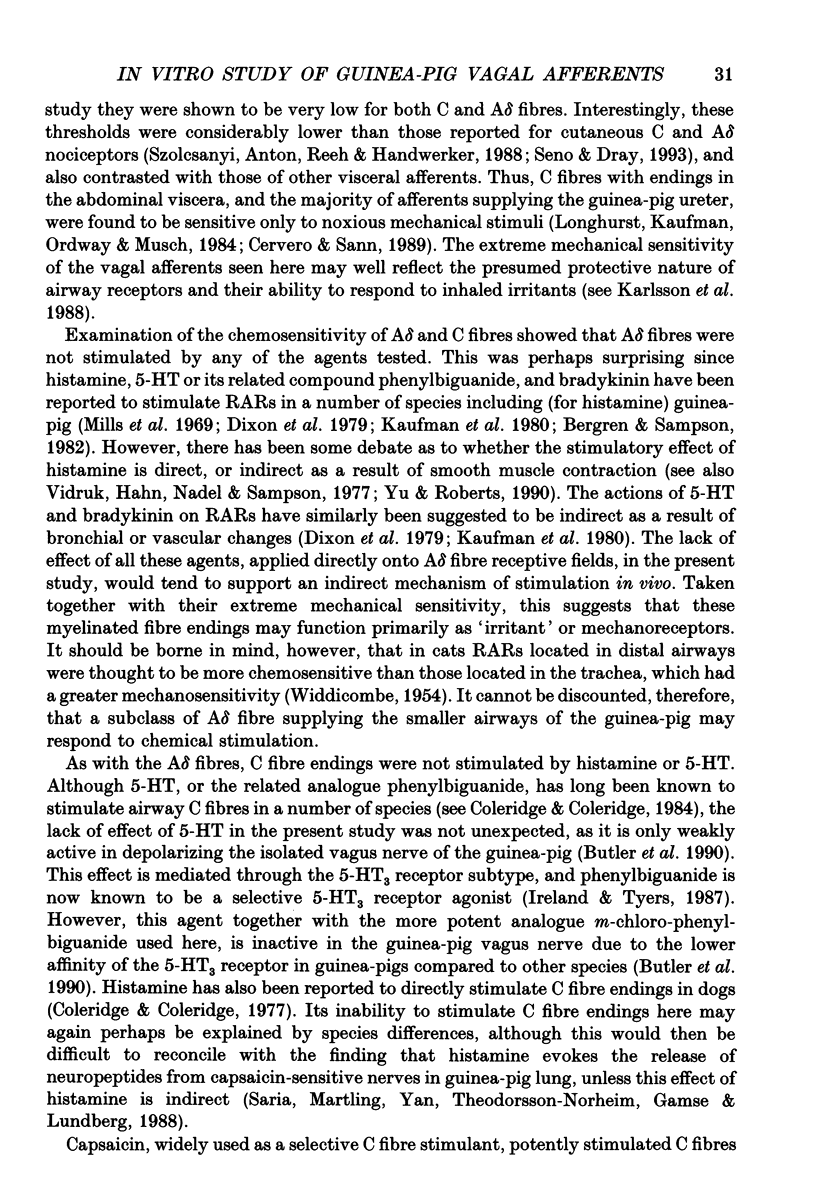
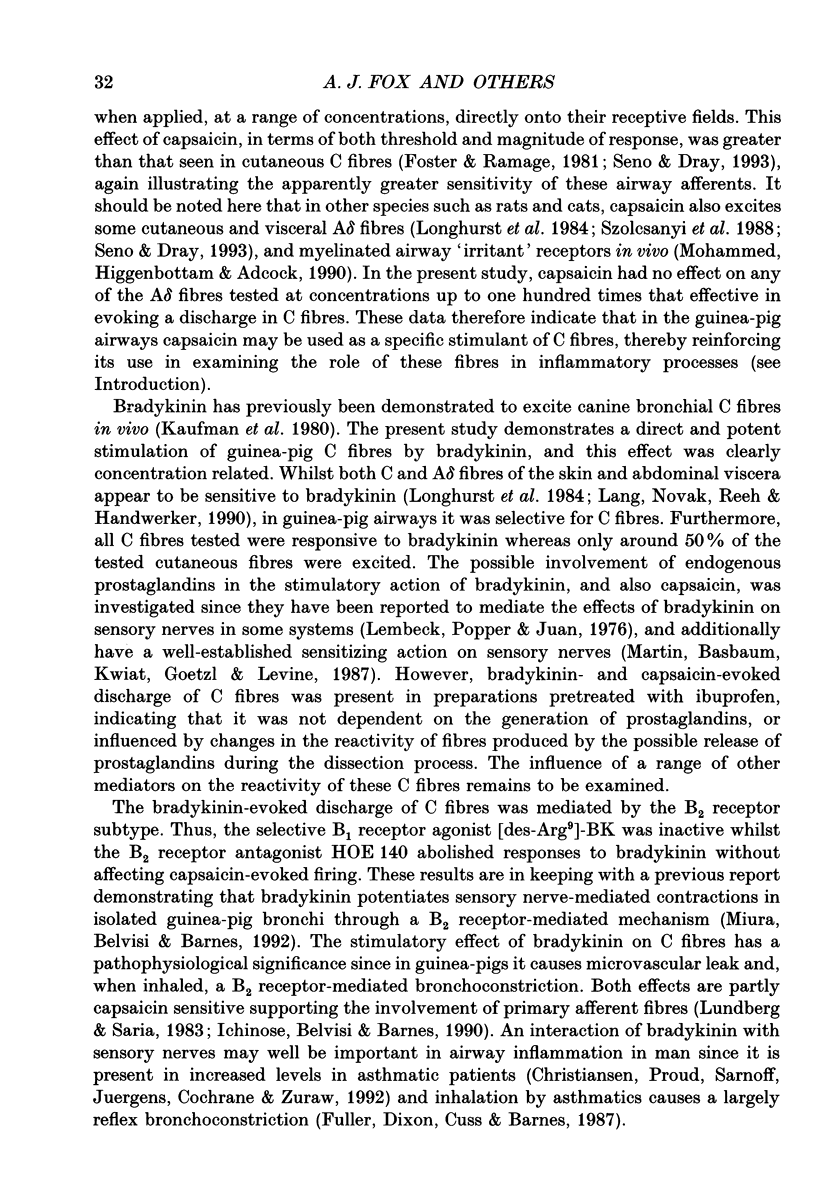
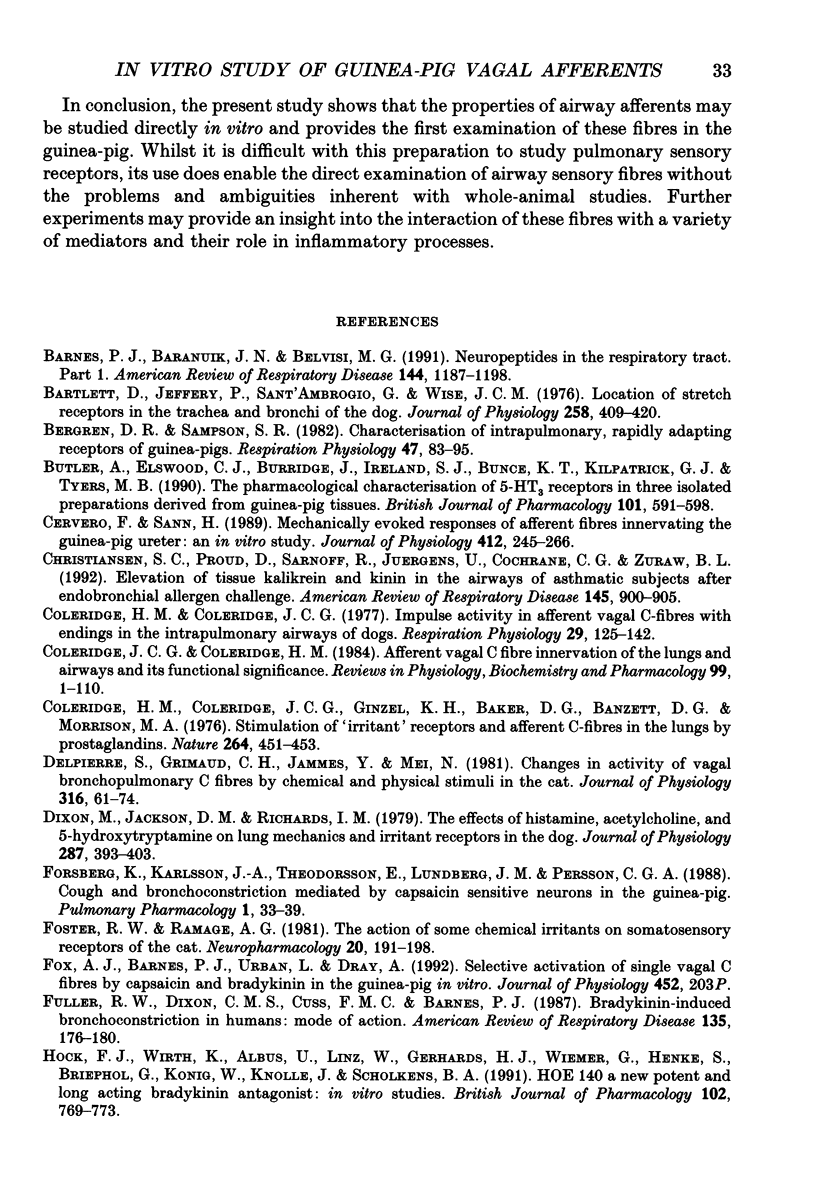
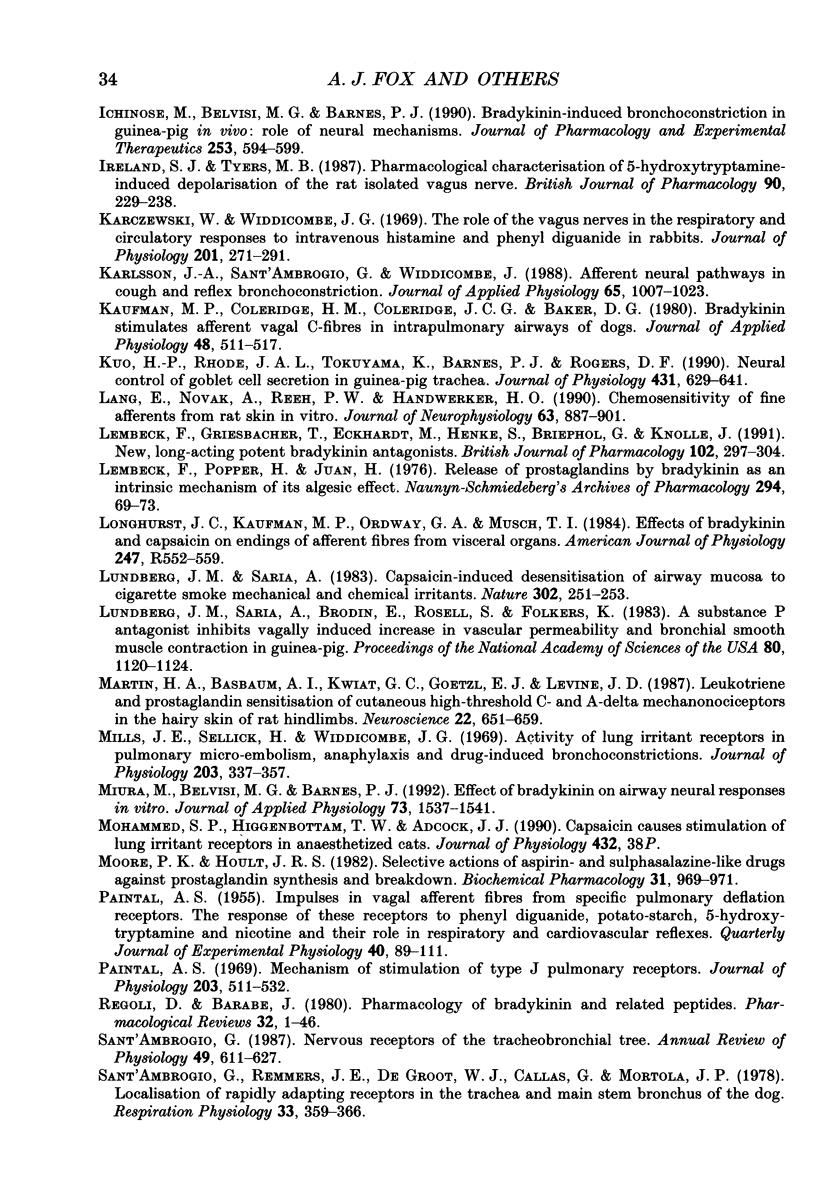
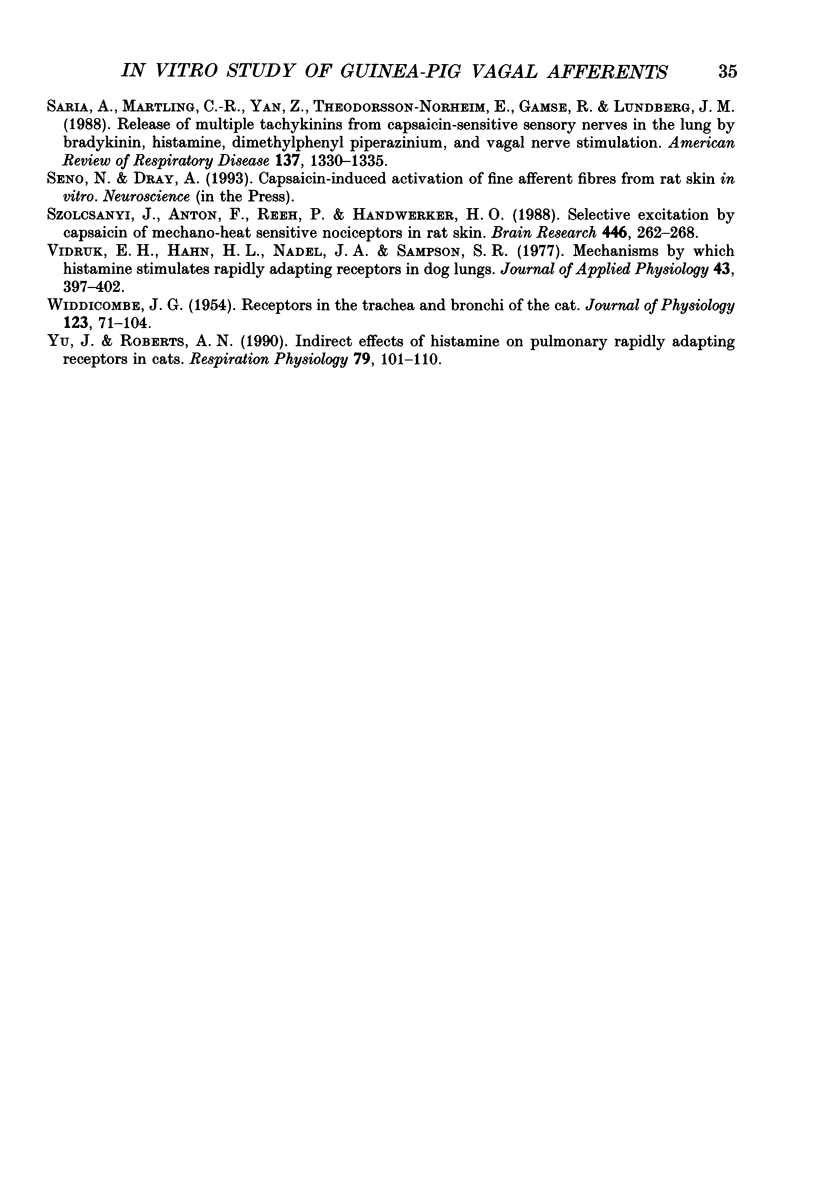
Selected References
These references are in PubMed. This may not be the complete list of references from this article.
- Barnes P. J., Baraniuk J. N., Belvisi M. G. Neuropeptides in the respiratory tract. Part I. Am Rev Respir Dis. 1991 Nov;144(5):1187–1198. doi: 10.1164/ajrccm/144.5.1187. [DOI] [PubMed] [Google Scholar]
- Bartlett D., Jr, Jeffery P., Sant'ambrogio G., Wise J. C. Location of stretch receptors in the trachea and bronchi of the dog. J Physiol. 1976 Jun;258(2):409–420. doi: 10.1113/jphysiol.1976.sp011427. [DOI] [PMC free article] [PubMed] [Google Scholar]
- Bergren D. R., Sampson S. R. Characterization of intrapulmonary, rapidly adapting receptors of guinea pigs. Respir Physiol. 1982 Jan;47(1):83–95. doi: 10.1016/0034-5687(82)90094-9. [DOI] [PubMed] [Google Scholar]
- Butler A., Elswood C. J., Burridge J., Ireland S. J., Bunce K. T., Kilpatrick G. J., Tyers M. B. The pharmacological characterization of 5-HT3 receptors in three isolated preparations derived from guinea-pig tissues. Br J Pharmacol. 1990 Nov;101(3):591–598. doi: 10.1111/j.1476-5381.1990.tb14126.x. [DOI] [PMC free article] [PubMed] [Google Scholar]
- Cervero F., Sann H. Mechanically evoked responses of afferent fibres innervating the guinea-pig's ureter: an in vitro study. J Physiol. 1989 May;412:245–266. doi: 10.1113/jphysiol.1989.sp017613. [DOI] [PMC free article] [PubMed] [Google Scholar]
- Christiansen S. C., Proud D., Sarnoff R. B., Juergens U., Cochrane C. G., Zuraw B. L. Elevation of tissue kallikrein and kinin in the airways of asthmatic subjects after endobronchial allergen challenge. Am Rev Respir Dis. 1992 Apr;145(4 Pt 1):900–905. doi: 10.1164/ajrccm/145.4_Pt_1.900. [DOI] [PubMed] [Google Scholar]
- Coleridge H. M., Coleridge J. C., Ginzel K. H., Baker D. G., Banzett R. B., Morrison M. A. Stimulation of 'irritant' receptors and afferent C-fibres in the lungs by prostaglandins. Nature. 1976 Dec 2;264(5585):451–453. doi: 10.1038/264451a0. [DOI] [PubMed] [Google Scholar]
- Coleridge H. M., Coleridge J. C. Impulse activity in afferent vagal C-fibres with endings in the intrapulmonary airways of dogs. Respir Physiol. 1977 Apr;29(2):125–142. doi: 10.1016/0034-5687(77)90086-x. [DOI] [PubMed] [Google Scholar]
- Coleridge J. C., Coleridge H. M. Afferent vagal C fibre innervation of the lungs and airways and its functional significance. Rev Physiol Biochem Pharmacol. 1984;99:1–110. doi: 10.1007/BFb0027715. [DOI] [PubMed] [Google Scholar]
- Delpierre S., Grimaud C., Jammes Y., Mei N. Changes in activity of vagal bronchopulmonary C fibres by chemical and physical stimuli in the cat. J Physiol. 1981 Jul;316:61–74. doi: 10.1113/jphysiol.1981.sp013772. [DOI] [PMC free article] [PubMed] [Google Scholar]
- Dixon M., Jackson D. M., Richards I. M. The effects of histamine, acetylcholine and 5-hydroxytryptamine on lung mechanics and irritant receptors in the dog. J Physiol. 1979 Feb;287:393–403. doi: 10.1113/jphysiol.1979.sp012666. [DOI] [PMC free article] [PubMed] [Google Scholar]
- Forsberg K., Karlsson J. A., Theodorsson E., Lundberg J. M., Persson C. G. Cough and bronchoconstriction mediated by capsaicin-sensitive sensory neurons in the guinea-pig. Pulm Pharmacol. 1988;1(1):33–39. doi: 10.1016/0952-0600(88)90008-7. [DOI] [PubMed] [Google Scholar]
- Foster R. W., Ramage A. G. The action of some chemical irritants on somatosensory receptors of the cat. Neuropharmacology. 1981 Feb;20(2):191–198. doi: 10.1016/0028-3908(81)90203-3. [DOI] [PubMed] [Google Scholar]
- Fuller R. W., Dixon C. M., Cuss F. M., Barnes P. J. Bradykinin-induced bronchoconstriction in humans. Mode of action. Am Rev Respir Dis. 1987 Jan;135(1):176–180. doi: 10.1164/arrd.1987.135.1.176. [DOI] [PubMed] [Google Scholar]
- Hock F. J., Wirth K., Albus U., Linz W., Gerhards H. J., Wiemer G., Henke S., Breipohl G., König W., Knolle J. Hoe 140 a new potent and long acting bradykinin-antagonist: in vitro studies. Br J Pharmacol. 1991 Mar;102(3):769–773. doi: 10.1111/j.1476-5381.1991.tb12248.x. [DOI] [PMC free article] [PubMed] [Google Scholar]
- Ichinose M., Belvisi M. G., Barnes P. J. Bradykinin-induced bronchoconstriction in guinea pig in vivo: role of neural mechanisms. J Pharmacol Exp Ther. 1990 May;253(2):594–599. [PubMed] [Google Scholar]
- Ireland S. J., Tyers M. B. Pharmacological characterization of 5-hydroxytryptamine-induced depolarization of the rat isolated vagus nerve. Br J Pharmacol. 1987 Jan;90(1):229–238. doi: 10.1111/j.1476-5381.1987.tb16844.x. [DOI] [PMC free article] [PubMed] [Google Scholar]
- Karczewski W., Widdicombe J. G. The role of the vagus nerves in the respiratory and circulatory responses to intravenous histamine and phenyl diguanide in rabbits. J Physiol. 1969 Apr;201(2):271–291. doi: 10.1113/jphysiol.1969.sp008755. [DOI] [PMC free article] [PubMed] [Google Scholar]
- Karlsson J. A., Sant'Ambrogio G., Widdicombe J. Afferent neural pathways in cough and reflex bronchoconstriction. J Appl Physiol (1985) 1988 Sep;65(3):1007–1023. doi: 10.1152/jappl.1988.65.3.1007. [DOI] [PubMed] [Google Scholar]
- Kaufman M. P., Coleridge H. M., Coleridge J. C., Baker D. G. Bradykinin stimulates afferent vagal C-fibers in intrapulmonary airways of dogs. J Appl Physiol Respir Environ Exerc Physiol. 1980 Mar;48(3):511–517. doi: 10.1152/jappl.1980.48.3.511. [DOI] [PubMed] [Google Scholar]
- Kuo H. P., Rohde J. A., Tokuyama K., Barnes P. J., Rogers D. F. Capsaicin and sensory neuropeptide stimulation of goblet cell secretion in guinea-pig trachea. J Physiol. 1990 Dec;431:629–641. doi: 10.1113/jphysiol.1990.sp018351. [DOI] [PMC free article] [PubMed] [Google Scholar]
- Lang E., Novak A., Reeh P. W., Handwerker H. O. Chemosensitivity of fine afferents from rat skin in vitro. J Neurophysiol. 1990 Apr;63(4):887–901. doi: 10.1152/jn.1990.63.4.887. [DOI] [PubMed] [Google Scholar]
- Lembeck F., Griesbacher T., Eckhardt M., Henke S., Breipohl G., Knolle J. New, long-acting, potent bradykinin antagonists. Br J Pharmacol. 1991 Feb;102(2):297–304. doi: 10.1111/j.1476-5381.1991.tb12169.x. [DOI] [PMC free article] [PubMed] [Google Scholar]
- Lembeck F., Popper H., Juan H. Release of prostaglandins by bradykinin as an intrinsic mechanism of its algesic effect. Naunyn Schmiedebergs Arch Pharmacol. 1976 Jul;294(1):69–73. doi: 10.1007/BF00692786. [DOI] [PubMed] [Google Scholar]
- Longhurst J. C., Kaufman M. P., Ordway G. A., Musch T. I. Effects of bradykinin and capsaicin on endings of afferent fibers from abdominal visceral organs. Am J Physiol. 1984 Sep;247(3 Pt 2):R552–R559. doi: 10.1152/ajpregu.1984.247.3.R552. [DOI] [PubMed] [Google Scholar]
- Lundberg J. M., Saria A., Brodin E., Rosell S., Folkers K. A substance P antagonist inhibits vagally induced increase in vascular permeability and bronchial smooth muscle contraction in the guinea pig. Proc Natl Acad Sci U S A. 1983 Feb;80(4):1120–1124. doi: 10.1073/pnas.80.4.1120. [DOI] [PMC free article] [PubMed] [Google Scholar]
- Lundberg J. M., Saria A. Capsaicin-induced desensitization of airway mucosa to cigarette smoke, mechanical and chemical irritants. Nature. 1983 Mar 17;302(5905):251–253. doi: 10.1038/302251a0. [DOI] [PubMed] [Google Scholar]
- Martin H. A., Basbaum A. I., Kwiat G. C., Goetzl E. J., Levine J. D. Leukotriene and prostaglandin sensitization of cutaneous high-threshold C- and A-delta mechanonociceptors in the hairy skin of rat hindlimbs. Neuroscience. 1987 Aug;22(2):651–659. doi: 10.1016/0306-4522(87)90360-5. [DOI] [PubMed] [Google Scholar]
- Mills J. E., Sellick H., Widdicombe J. G. Activity of lung irritant receptors in pulmonary microembolism, anaphylaxis and drug-induced bronchoconstrictions. J Physiol. 1969 Aug;203(2):337–357. doi: 10.1113/jphysiol.1969.sp008867. [DOI] [PMC free article] [PubMed] [Google Scholar]
- Miura M., Belvisi M. G., Barnes P. J. Effect of bradykinin on airway neural responses in vitro. J Appl Physiol (1985) 1992 Oct;73(4):1537–1541. doi: 10.1152/jappl.1992.73.4.1537. [DOI] [PubMed] [Google Scholar]
- Moore P. K., Hoult J. R. Selective actions of aspirin- and sulphasalazine-like drugs against prostaglandin synthesis and breakdown. Biochem Pharmacol. 1982 Mar 15;31(6):969–971. doi: 10.1016/0006-2952(82)90329-x. [DOI] [PubMed] [Google Scholar]
- PAINTAL B. A. Impulses in vagal afferent fibres from specific pulmonary deflation receptors: the response of these receptors to phenyl diguanide, potato starch, 5-hydroxytryptamine and nicotine, and their rôle in respiratory and cardiovascular reflexes. Q J Exp Physiol Cogn Med Sci. 1955 Apr;40(2):89–111. doi: 10.1113/expphysiol.1955.sp001116. [DOI] [PubMed] [Google Scholar]
- Paintal A. S. Mechanism of stimulation of type J pulmonary receptors. J Physiol. 1969 Aug;203(3):511–532. doi: 10.1113/jphysiol.1969.sp008877. [DOI] [PMC free article] [PubMed] [Google Scholar]
- Regoli D., Barabé J. Pharmacology of bradykinin and related kinins. Pharmacol Rev. 1980 Mar;32(1):1–46. [PubMed] [Google Scholar]
- Sant'Ambrogio G. Nervous receptors of the tracheobronchial tree. Annu Rev Physiol. 1987;49:611–627. doi: 10.1146/annurev.ph.49.030187.003143. [DOI] [PubMed] [Google Scholar]
- Sant'Ambrogio G., Remmers J. E., de Groot W. J., Callas G., Mortola J. P. Localization of rapidly adapting receptors in the trachea and main stem bronchus of the dog. Respir Physiol. 1978 Jun;33(3):359–366. doi: 10.1016/0034-5687(78)90062-2. [DOI] [PubMed] [Google Scholar]
- Saria A., Martling C. R., Yan Z., Theodorsson-Norheim E., Gamse R., Lundberg J. M. Release of multiple tachykinins from capsaicin-sensitive sensory nerves in the lung by bradykinin, histamine, dimethylphenyl piperazinium, and vagal nerve stimulation. Am Rev Respir Dis. 1988 Jun;137(6):1330–1335. doi: 10.1164/ajrccm/137.6.1330. [DOI] [PubMed] [Google Scholar]
- Szolcsanyi J., Anton F., Reeh P. W., Handwerker H. O. Selective excitation by capsaicin of mechano-heat sensitive nociceptors in rat skin. Brain Res. 1988 Apr 19;446(2):262–268. doi: 10.1016/0006-8993(88)90885-2. [DOI] [PubMed] [Google Scholar]
- Vidruk E. H., Hahn H. L., Nadel J. A., Sampson S. R. Mechanisms by which histamine stimulates rapidly adapting receptors in dog lungs. J Appl Physiol Respir Environ Exerc Physiol. 1977 Sep;43(3):397–402. doi: 10.1152/jappl.1977.43.3.397. [DOI] [PubMed] [Google Scholar]
- WIDDICOMBE J. G. Receptors in the trachea and bronchi of the cat. J Physiol. 1954 Jan;123(1):71–104. doi: 10.1113/jphysiol.1954.sp005034. [DOI] [PMC free article] [PubMed] [Google Scholar]
- Yu J., Roberts A. M. Indirect effects of histamine on pulmonary rapidly adapting receptors in cats. Respir Physiol. 1990 Feb;79(2):101–110. doi: 10.1016/0034-5687(90)90010-v. [DOI] [PubMed] [Google Scholar]


